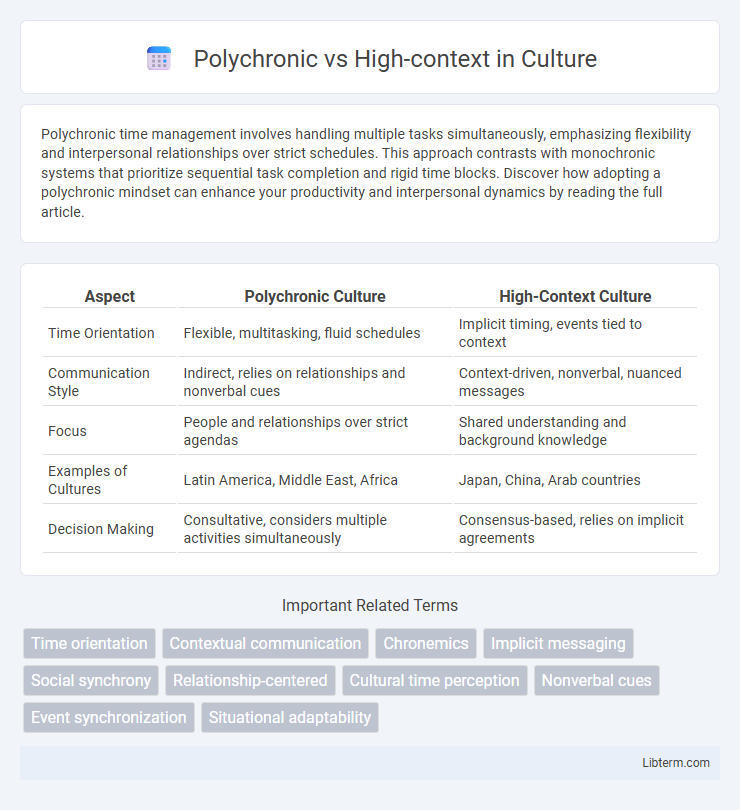Polychronic time management involves handling multiple tasks simultaneously, emphasizing flexibility and interpersonal relationships over strict schedules. This approach contrasts with monochronic systems that prioritize sequential task completion and rigid time blocks. Discover how adopting a polychronic mindset can enhance your productivity and interpersonal dynamics by reading the full article.
Table of Comparison
| Aspect | Polychronic Culture | High-Context Culture |
|---|---|---|
| Time Orientation | Flexible, multitasking, fluid schedules | Implicit timing, events tied to context |
| Communication Style | Indirect, relies on relationships and nonverbal cues | Context-driven, nonverbal, nuanced messages |
| Focus | People and relationships over strict agendas | Shared understanding and background knowledge |
| Examples of Cultures | Latin America, Middle East, Africa | Japan, China, Arab countries |
| Decision Making | Consultative, considers multiple activities simultaneously | Consensus-based, relies on implicit agreements |
Understanding Polychronic Cultures
Polychronic cultures prioritize multitasking and value relationships over strict schedules, emphasizing the fluidity of time and social interactions. In these high-context environments, communication relies heavily on shared experiences and implicit messages rather than explicit verbal information. Understanding polychronic cultures requires recognizing their flexible approach to time management and the importance of building trust through nonverbal cues and context-driven exchanges.
Defining High-Context Communication
High-context communication relies heavily on implicit messages and nonverbal cues, where meaning is derived from the surrounding context rather than explicitly stated words. It is common in cultures with strong social bonds and shared experiences, such as Japan, China, and Arab countries, where much of the communication is understood without direct expression. Polychronic cultures often overlap with high-context communication, valuing relationships and multitasking while interpreting subtle signals within interactions.
Key Differences: Polychronic vs High-Context
Polychronic cultures manage multiple tasks simultaneously and value relationships over strict schedules, while high-context cultures communicate through indirect, implicit messages relying heavily on shared experiences and nonverbal cues. The key difference lies in time orientation and communication style: polychronic emphasizes flexible time management, whereas high-context prioritizes contextual understanding and nuanced interactions. Both influence workplace dynamics by shaping collaboration, decision-making, and conflict resolution approaches.
Time Perception in Polychronic Cultures
Polychronic cultures perceive time as flexible, valuing relationships and multitasking over strict schedules, which contrasts with monochronic cultures that prioritize punctuality and sequential task completion. In high-context polychronic societies such as those in Latin America and the Middle East, time is viewed as a fluid resource, often leading to overlapping activities and a relaxed approach to deadlines. This flexible time perception emphasizes personal interactions and situational context, influencing communication and business practices significantly.
Communication Styles in High-Context Societies
High-context societies rely heavily on implicit messages, non-verbal cues, and shared experiences, making communication indirect and nuanced. Polychronic cultures, typical of high-context environments, manage multiple conversations and tasks simultaneously, reflecting flexible time perceptions. Understanding these communication styles enhances cross-cultural interactions by emphasizing relational context and unspoken understandings.
Social Interactions and Relationship Building
Polychronic cultures emphasize simultaneous social interactions, valuing multitasking and fluid time management to strengthen interpersonal relationships. High-context communication relies heavily on shared experiences and non-verbal cues, fostering deeper trust and nuanced understanding among individuals. Together, these approaches cultivate rich, enduring social bonds through implicit communication and flexible engagement patterns.
Workplace Dynamics: Scheduling vs Messaging
Polychronic cultures in workplace dynamics prefer flexible scheduling, allowing multiple tasks and interactions to occur simultaneously, fostering informal communication and adaptability. High-context communication emphasizes implicit messaging, relying heavily on non-verbal cues, shared experiences, and context rather than explicit verbal instructions. Understanding these differences improves collaboration by aligning expectations around scheduling flexibility and the interpretation of messages in multicultural teams.
Challenges in Cross-Cultural Communication
Polychronic cultures emphasize multitasking and fluid time management, while high-context cultures rely heavily on implicit communication and shared understanding, creating challenges in cross-cultural interactions where directness and time perceptions differ. Misinterpretations often arise when polychronic individuals perceive high-context communication as vague or indirect, and high-context individuals view polychronic approaches as disorganized or disrespectful to social cues. Effective cross-cultural communication requires awareness of these differences, emphasizing adaptability and sensitivity to varying time orientations and contextual cues.
Practical Examples of Polychronic and High-Context Behaviors
In polychronic cultures such as Mexico and India, individuals often juggle multiple tasks simultaneously, prioritizing relationships over strict adherence to schedules, evident in social gatherings running late yet maintaining strong interpersonal bonds. High-context communication, common in Japan and Arab countries, relies heavily on non-verbal cues and shared understanding, where messages are implicit and require reading between the lines, such as indirect refusals or subtle body language signals. These contrasting behaviors influence workplace interactions, with polychronic settings embracing fluid deadlines and multitasking, while high-context environments emphasize harmony and unspoken expectations in teamwork.
Strategies for Navigating Diverse Cultural Approaches
Navigating polychronic and high-context cultural frameworks requires emphasizing flexibility in scheduling and fostering deep relational communication to align with non-linear time perceptions and implicit messaging. Strategies include prioritizing relationship-building through active listening and reading non-verbal cues while adapting project timelines to accommodate simultaneous tasks common in polychronic environments. Understanding context-dependent interactions and valuing harmony over explicit directive communication strengthens cross-cultural collaboration and minimizes misunderstandings.
Polychronic Infographic

 libterm.com
libterm.com